engine HYUNDAI KONA EV 2022 Owners Manual
[x] Cancel search | Manufacturer: HYUNDAI, Model Year: 2022, Model line: KONA EV, Model: HYUNDAI KONA EV 2022Pages: 548, PDF Size: 49.14 MB
Page 7 of 548
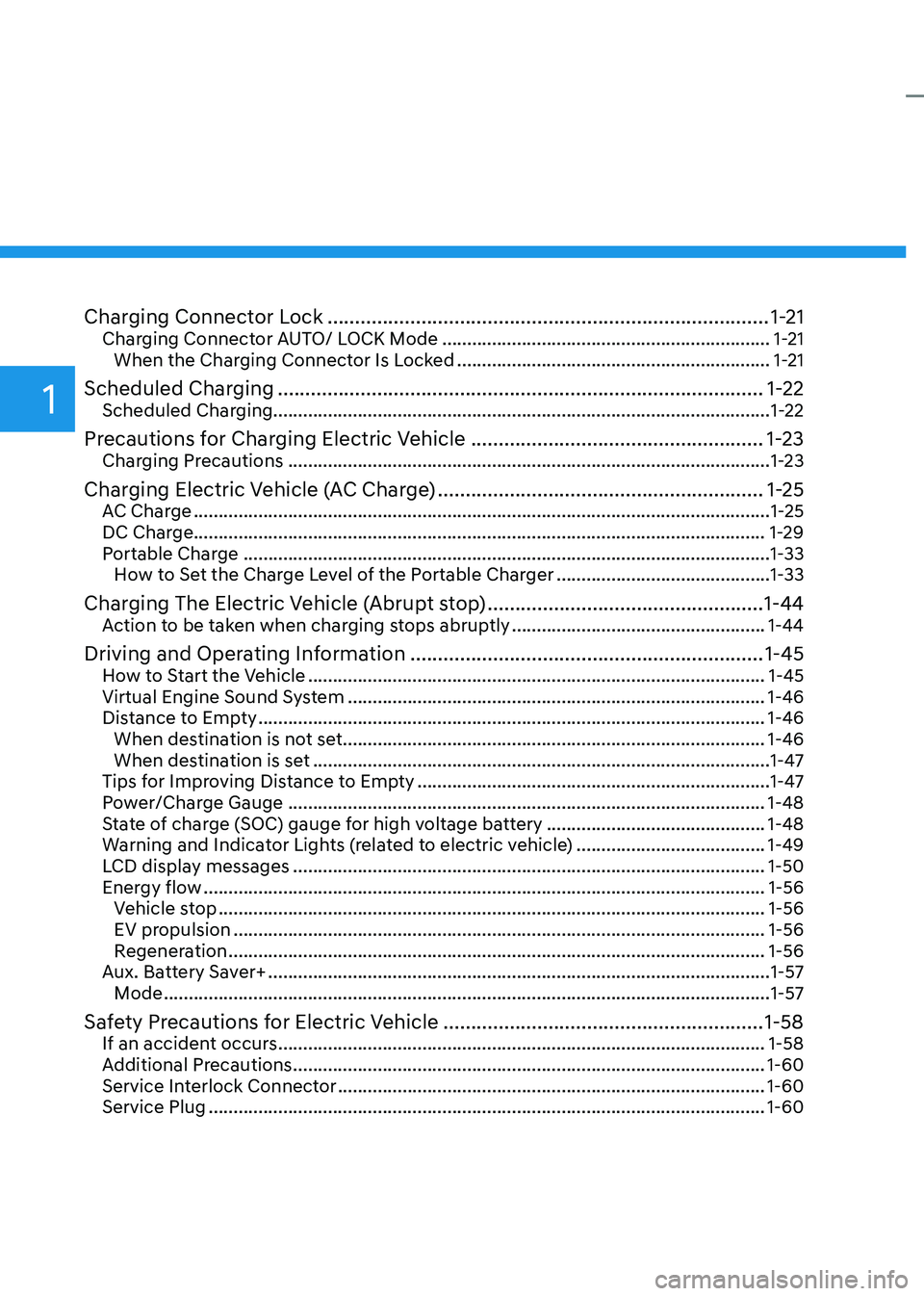
1
Charging Connector Lock ................................................................................ 1-21
Charging Connector AUTO/ LOCK Mode .................................................................. 1-21
When the Charging Connector Is Locked ...............................................................1-21
Scheduled Charging ........................................................................................ 1-22
Scheduled Charging....................................................................................................1-22
Precautions for Charging Electric Vehicle .....................................................1-23
Charging Precautions ................................................................................................. 1-23
Charging Electric Vehicle (AC Charge) ...........................................................1-25
AC Charge .................................................................................................................... 1-25
DC Charge................................................................................................................... 1-29 Portable Charge .......................................................................................................... 1-33
How to Set the Charge Level of the Portable Charger ...........................................1-33
Charging The Electric Vehicle (Abrupt stop) ..................................................1-44
Action to be taken when charging stops abruptly ...................................................1-44
Driving and Operating Information ................................................................ 1-45
How to Start the Vehicle ............................................................................................ 1-45
Virtual Engine Sound System .................................................................................... 1-46
Distance to Empty ...................................................................................................... 1-46
When destination is not set ..................................................................................... 1-46
When destination is set ............................................................................................ 1-47
Tips for Improving Distance to Empty ....................................................................... 1-47
Power/Charge Gauge ................................................................................................ 1-48
State of charge (SOC) gauge for high voltage battery ............................................1-48
Warning and Indicator Lights (related to electric vehicle) ......................................1-49
LCD display messages ............................................................................................... 1-50
Energy flow ................................................................................................................. 1-56
Vehicle stop .............................................................................................................. 1-56
EV propulsion ........................................................................................................... 1-56
Regeneration ............................................................................................................ 1-56
Aux. Battery Saver+ ..................................................................................................... 1-57
Mode .......................................................................................................................... 1-57
Safety Precautions for Electric Vehicle ..........................................................1-58
If an accident occurs .................................................................................................. 1-58
Additional Precautions ............................................................................................... 1-60
Service Interlock Connector ...................................................................................... 1-60
Service Plug ................................................................................................................ 1-60
Page 8 of 548
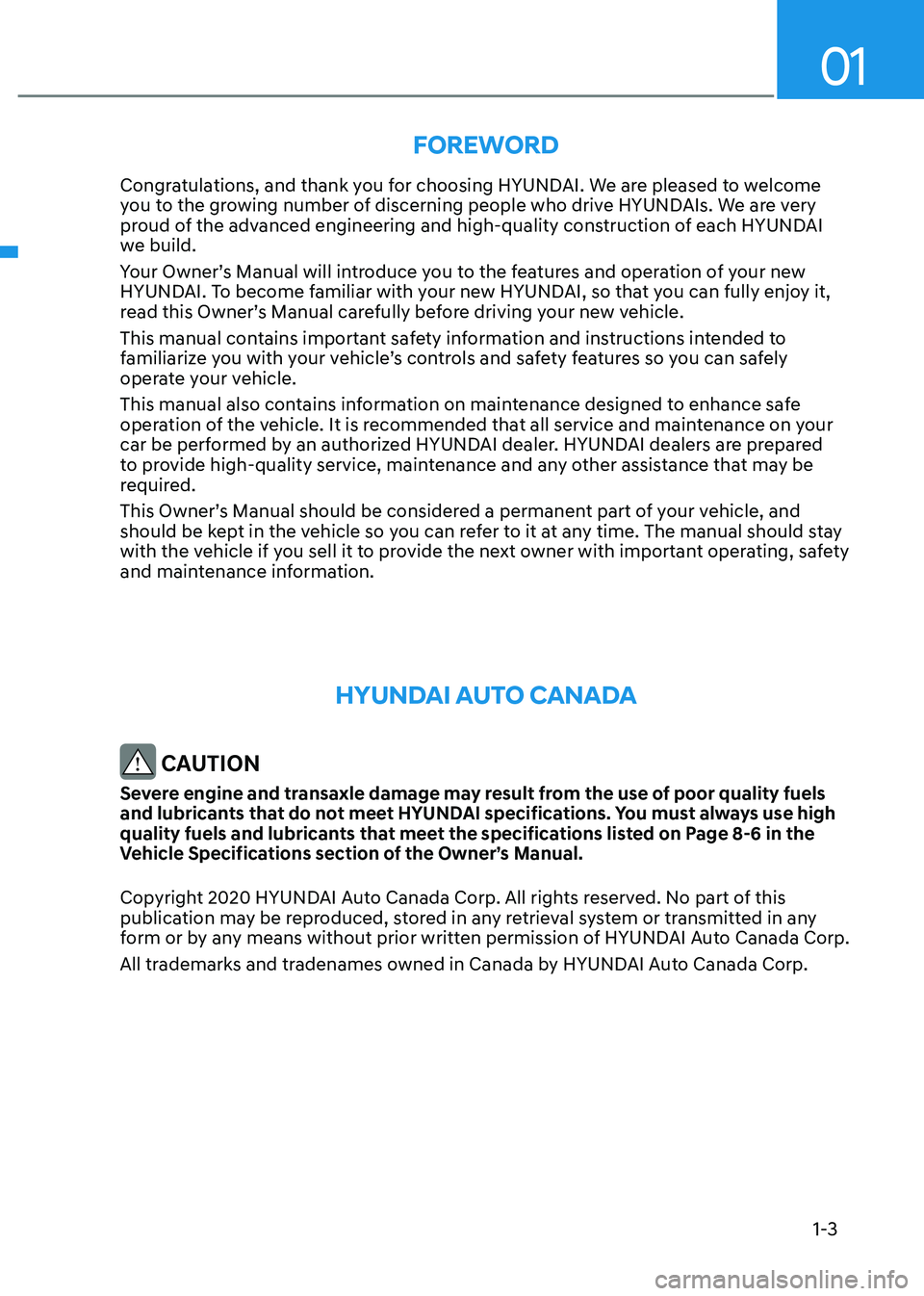
01
1-3
Foreword
Congratulations, and thank you for choosing HYUNDAI. We are pleased to welcome
you to the growing number of discerning people who drive HYUNDAIs. We are very
proud of the advanced engineering and high-quality construction of each HYUNDAI
we build.
Your Owner’s Manual will introduce you to the features and operation of your new
HYUNDAI. To become familiar with your new HYUNDAI, so that you can fully enjoy it,
read this Owner’s Manual carefully before driving your new vehicle.
This manual contains important safety information and instructions intended to
familiarize you with your vehicle’s controls and safety features so you can safely
operate your vehicle.
This manual also contains information on maintenance designed to enhance safe
operation of the vehicle. It is recommended that all service and maintenance on your
car be performed by an authorized HYUNDAI dealer. HYUNDAI dealers are prepared
to provide high-quality service, maintenance and any other assistance that may be
required.
This Owner’s Manual should be considered a permanent part of your vehicle, and
should be kept in the vehicle so you can refer to it at any time. The manual should stay
with the vehicle if you sell it to provide the next owner with important operating, safety
and maintenance information.
Hyundai auTo Canada
CAUTION
Severe engine and transaxle damage may result from the use of poor quality fuels
and lubricants that do not meet HYUNDAI specifications. You must always use high
quality fuels and lubricants that meet the specifications listed on Page 8-6 in the
Vehicle Specifications section of the Owner’s Manual.
Copyright 2020 HYUNDAI Auto Canada Corp. All rights reserved. No part of this
publication may be reproduced, stored in any retrieval system or transmitted in any
form or by any means without prior written permission of HYUNDAI Auto Canada Corp.
All trademarks and tradenames owned in Canada by HYUNDAI Auto Canada Corp.
Page 11 of 548
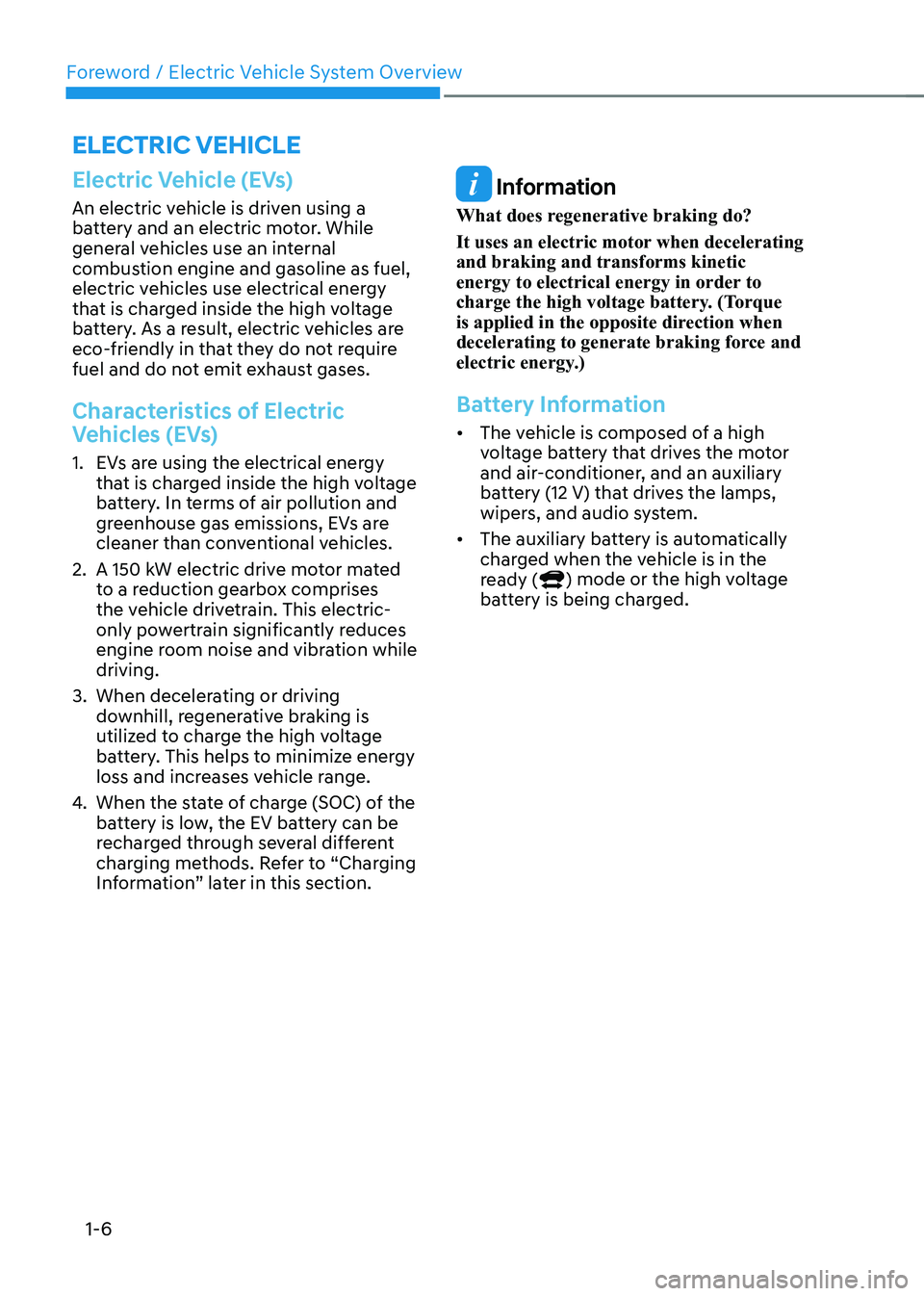
Foreword / Electric Vehicle System Overview
1-6
Electric Vehicle (EVs)
An electric vehicle is driven using a
battery and an electric motor. While
general vehicles use an internal
combustion engine and gasoline as fuel,
electric vehicles use electrical energy
that is charged inside the high voltage
battery. As a result, electric vehicles are
eco-friendly in that they do not require
fuel and do not emit exhaust gases.
Characteristics of Electric
Vehicles (EVs)
1. EVs are using the electrical energy that is charged inside the high voltage
battery. In terms of air pollution and
greenhouse gas emissions, EVs are
cleaner than conventional vehicles.
2. A 150 kW electric drive motor mated to a reduction gearbox comprises
the vehicle drivetrain. This electric-
only powertrain significantly reduces
engine room noise and vibration while driving.
3. When decelerating or driving downhill, regenerative braking is
utilized to charge the high voltage
battery. This helps to minimize energy
loss and increases vehicle range.
4. When the state of charge (SOC) of the
battery is low, the EV battery can be
recharged through several different
charging methods. Refer to “Charging
Information” later in this section.
Information
What does regenerative braking do?
It uses an electric motor when decelerating and braking and transforms kinetic
energy to electrical energy in order to
charge the high voltage battery. (Torque
is applied in the opposite direction when
decelerating to generate braking force and
electric energy.)
Battery Information
• The vehicle is composed of a high
voltage battery that drives the motor
and air-conditioner, and an auxiliary
battery (12 V) that drives the lamps,
wipers, and audio system.
• The auxiliary battery is automatically
charged when the vehicle is in the
ready (
) mode or the high voltage
battery is being charged.
eleCTriC VeHiCle
Page 51 of 548
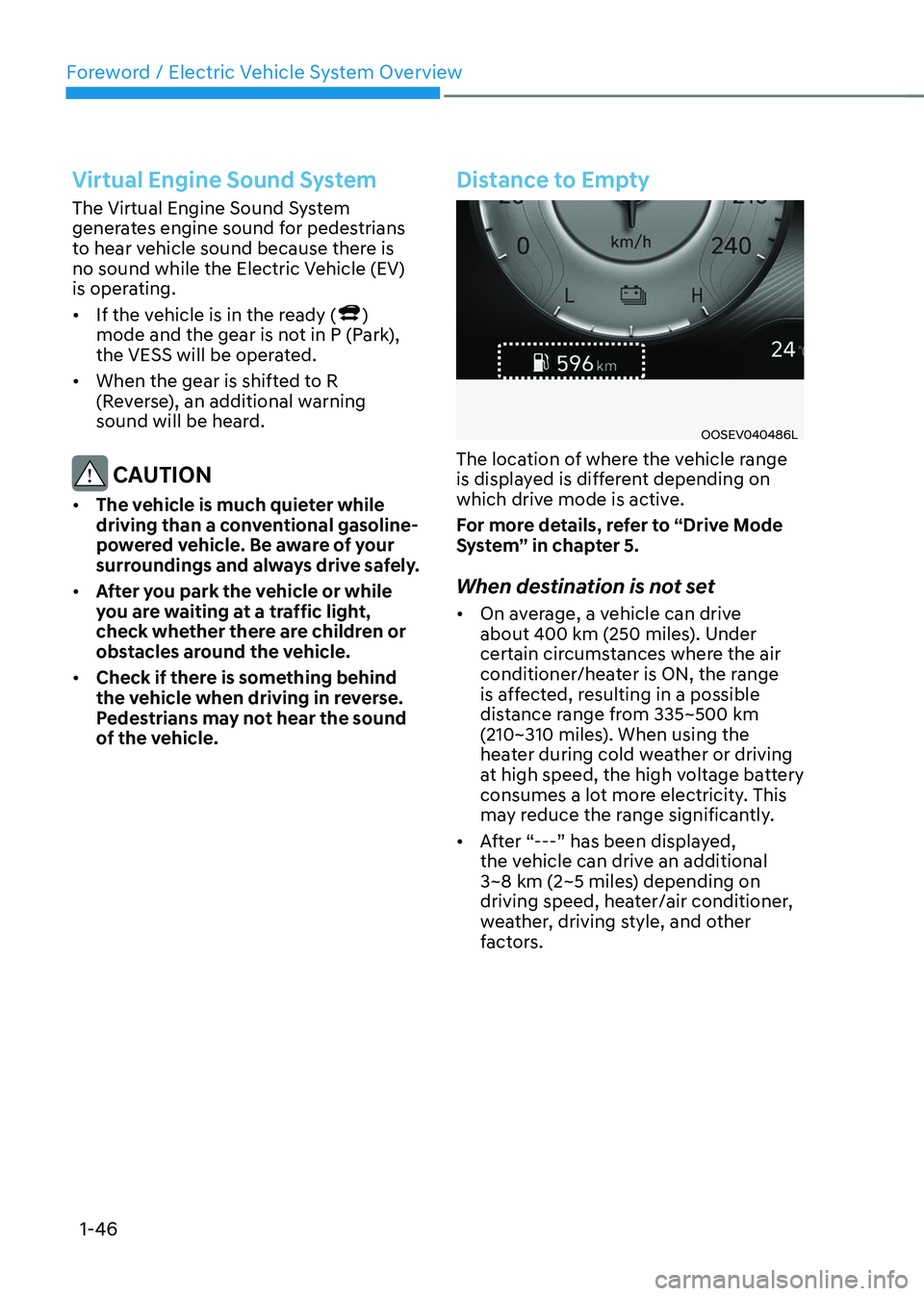
Foreword / Electric Vehicle System Overview
1-46
Virtual Engine Sound System
The Virtual Engine Sound System
generates engine sound for pedestrians
to hear vehicle sound because there is
no sound while the Electric Vehicle (EV)
is operating. • If the vehicle is in the ready (
)
mode and the gear is not in P (Park),
the VESS will be operated.
• When the gear is shifted to R
(Reverse), an additional warning
sound will be heard.
CAUTION
• The vehicle is much quieter while
driving than a conventional gasoline-
powered vehicle. Be aware of your
surroundings and always drive safely.
• After you park the vehicle or while
you are waiting at a traffic light,
check whether there are children or
obstacles around the vehicle.
• Check if there is something behind
the vehicle when driving in reverse.
Pedestrians may not hear the sound
of the vehicle.
Distance to Empty
OOSEV040486L
The location of where the vehicle range
is displayed is different depending on
which drive mode is active.
For more details, refer to “Drive Mode
System” in chapter 5.
When destination is not set • On average, a vehicle can drive
about 400 km (250 miles). Under
certain circumstances where the air
conditioner/heater is ON, the range
is affected, resulting in a possible
distance range from 335~500 km
(210~310 miles). When using the
heater during cold weather or driving
at high speed, the high voltage battery
consumes a lot more electricity. This
may reduce the range significantly.
• After “---” has been displayed,
the vehicle can drive an additional
3~8 km (2~5 miles) depending on
driving speed, heater/air conditioner,
weather, driving style, and other
factors.
Page 60 of 548
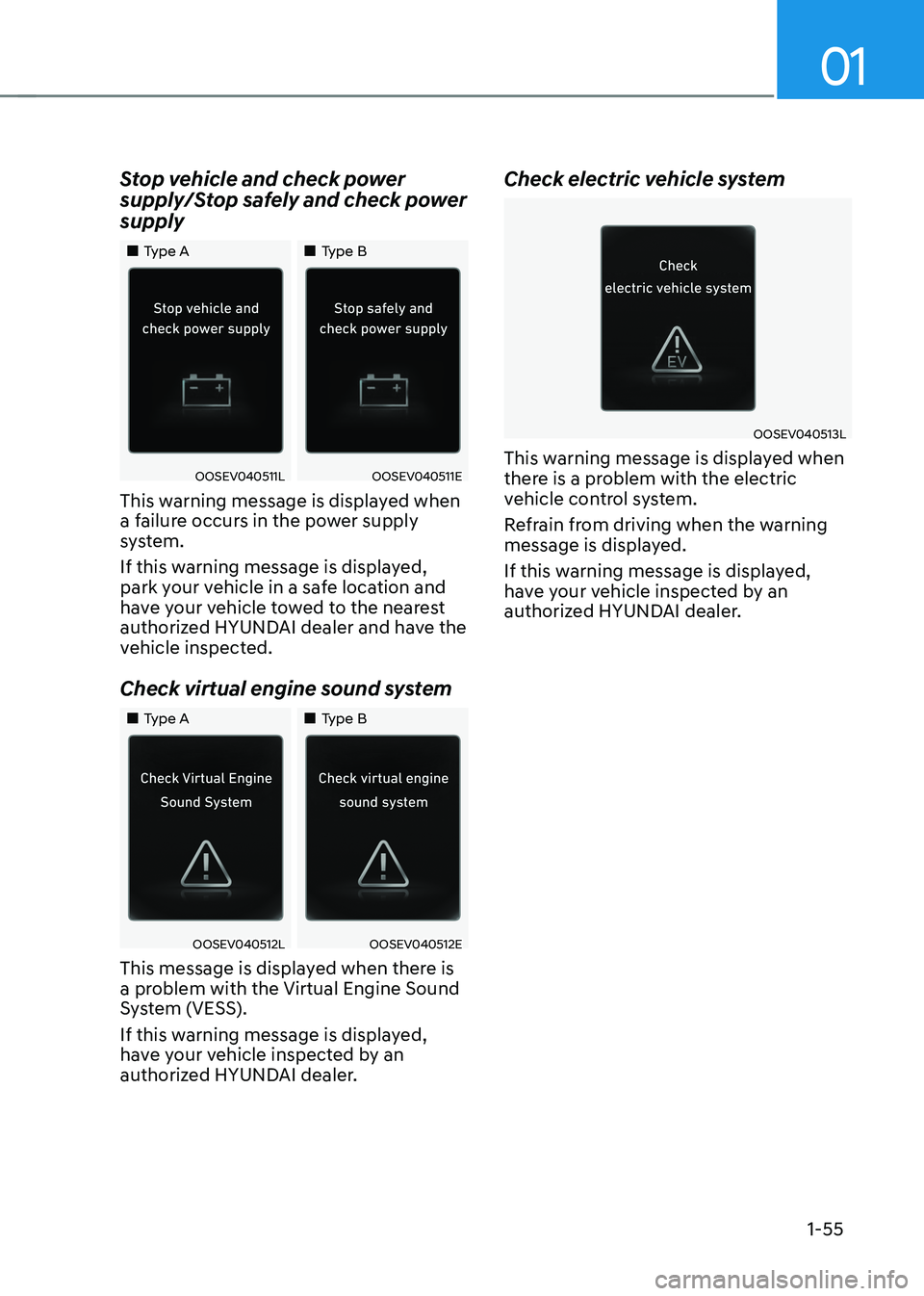
01
1-55
Stop vehicle and check power
supply/Stop safely and check power supply
„„Type A
„„Type B
OOSEV040511LOOSEV040511E
This warning message is displayed when
a failure occurs in the power supply
system.
If this warning message is displayed,
park your vehicle in a safe location and
have your vehicle towed to the nearest
authorized HYUNDAI dealer and have the
vehicle inspected.
Check virtual engine sound system
„„Type A „„Type B
OOSEV040512LOOSEV040512E
This message is displayed when there is
a problem with the Virtual Engine Sound
System (VESS).
If this warning message is displayed,
have your vehicle inspected by an
authorized HYUNDAI dealer. Check electric vehicle system
OOSEV040513L
This warning message is displayed when
there is a problem with the electric
vehicle control system.
Refrain from driving when the warning
message is displayed.
If this warning message is displayed,
have your vehicle inspected by an
authorized HYUNDAI dealer.
Page 127 of 548
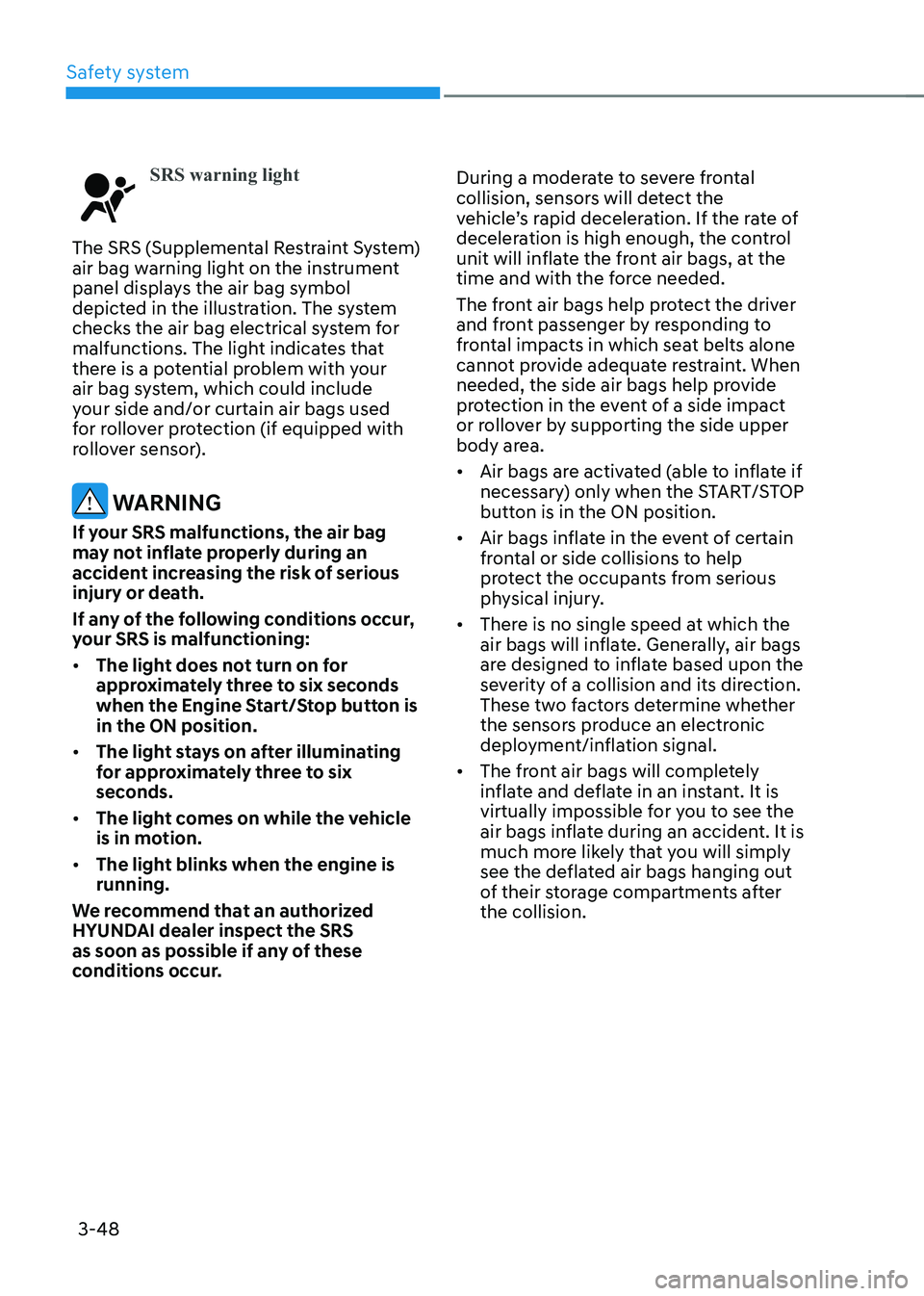
Safety system
3-48
SRS warning light
The SRS (Supplemental Restraint System)
air bag warning light on the instrument
panel displays the air bag symbol
depicted in the illustration. The system
checks the air bag electrical system for
malfunctions. The light indicates that
there is a potential problem with your
air bag system, which could include
your side and/or curtain air bags used
for rollover protection (if equipped with
rollover sensor).
WARNING
If your SRS malfunctions, the air bag
may not inflate properly during an
accident increasing the risk of serious
injury or death.
If any of the following conditions occur,
your SRS is malfunctioning: • The light does not turn on for
approximately three to six seconds
when the Engine Start/Stop button is in the ON position.
• The light stays on after illuminating
for approximately three to six
seconds.
• The light comes on while the vehicle
is in motion.
• The light blinks when the engine is running.
We recommend that an authorized
HYUNDAI dealer inspect the SRS
as soon as possible if any of these
conditions occur. During a moderate to severe frontal
collision, sensors will detect the
vehicle’s rapid deceleration. If the rate of
deceleration is high enough, the control
unit will inflate the front air bags, at the
time and with the force needed.
The front air bags help protect the driver
and front passenger by responding to
frontal impacts in which seat belts alone
cannot provide adequate restraint. When
needed, the side air bags help provide
protection in the event of a side impact
or rollover by supporting the side upper
body area. •
Air bags are activated (able to inflate if
necessary) only when the START/STOP
button is in the ON position.
• Air bags inflate in the event of certain
frontal or side collisions to help
protect the occupants from serious
physical injury.
• There is no single speed at which the
air bags will inflate. Generally, air bags
are designed to inflate based upon the
severity of a collision and its direction.
These two factors determine whether
the sensors produce an electronic
deployment/inflation signal.
• The front air bags will completely
inflate and deflate in an instant. It is
virtually impossible for you to see the
air bags inflate during an accident. It is
much more likely that you will simply
see the deflated air bags hanging out
of their storage compartments after the collision.
Page 135 of 548
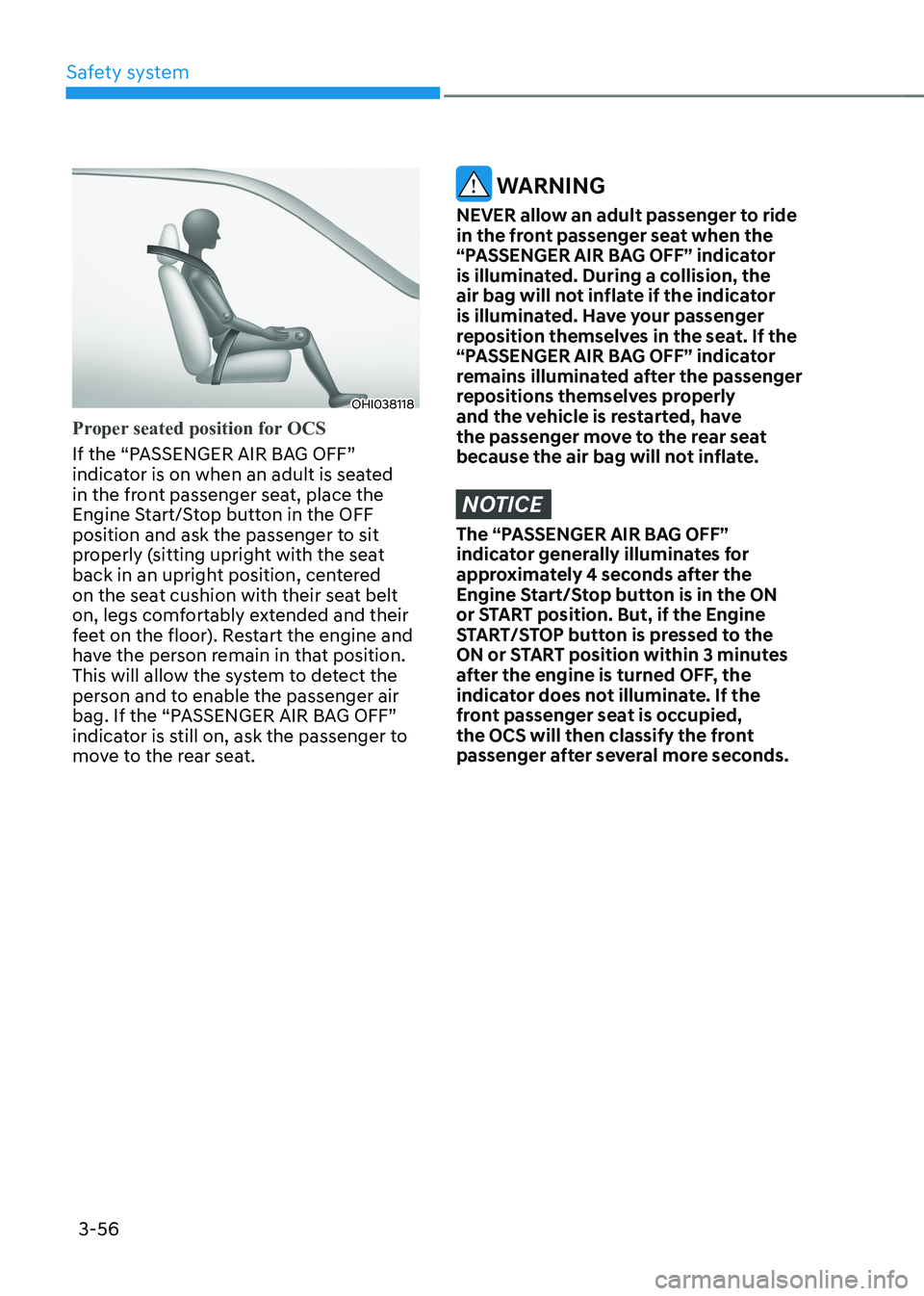
Safety system
3-56
OHI038118
Proper seated position for OCS
If the “PASSENGER AIR BAG OFF”
indicator is on when an adult is seated
in the front passenger seat, place the
Engine Start/Stop button in the OFF
position and ask the passenger to sit
properly (sitting upright with the seat
back in an upright position, centered
on the seat cushion with their seat belt
on, legs comfortably extended and their
feet on the floor). Restart the engine and
have the person remain in that position.
This will allow the system to detect the
person and to enable the passenger air
bag. If the “PASSENGER AIR BAG OFF”
indicator is still on, ask the passenger to
move to the rear seat.
WARNING
NEVER allow an adult passenger to ride
in the front passenger seat when the
“PASSENGER AIR BAG OFF” indicator
is illuminated. During a collision, the
air bag will not inflate if the indicator
is illuminated. Have your passenger
reposition themselves in the seat. If the
“PASSENGER AIR BAG OFF” indicator
remains illuminated after the passenger
repositions themselves properly
and the vehicle is restarted, have
the passenger move to the rear seat
because the air bag will not inflate.
NOTICE
The “PASSENGER AIR BAG OFF”
indicator generally illuminates for
approximately 4 seconds after the
Engine Start/Stop button is in the ON
or START position. But, if the Engine
START/STOP button is pressed to the
ON or START position within 3 minutes
after the engine is turned OFF, the
indicator does not illuminate. If the
front passenger seat is occupied,
the OCS will then classify the front
passenger after several more seconds.
Page 136 of 548
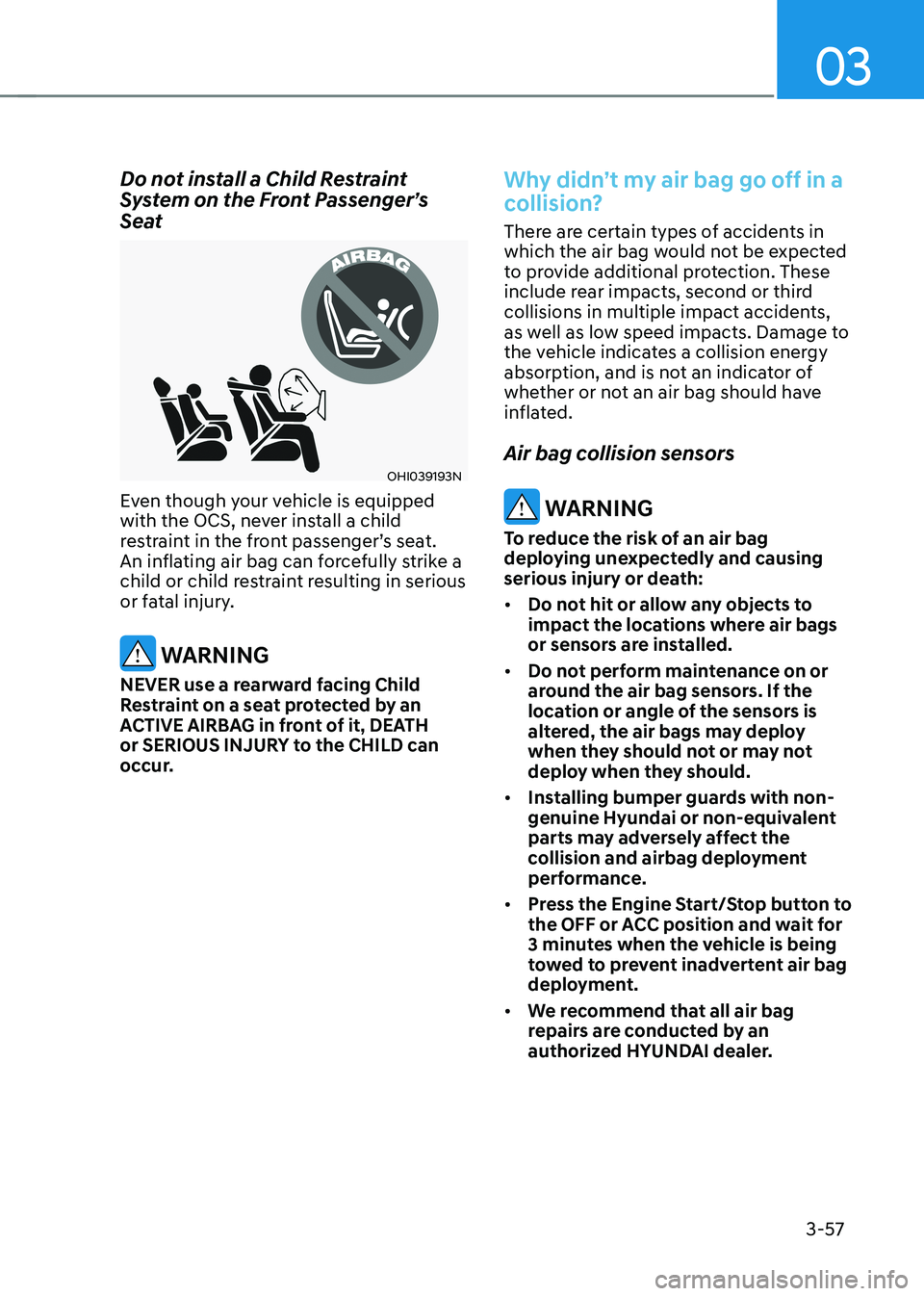
03
3-57
Do not install a Child Restraint
System on the Front Passenger’s
Seat
OHI039193N
Even though your vehicle is equipped
with the OCS, never install a child
restraint in the front passenger’s seat.
An inflating air bag can forcefully strike a
child or child restraint resulting in serious
or fatal injury.
WARNING
NEVER use a rearward facing Child
Restraint on a seat protected by an
ACTIVE AIRBAG in front of it, DEATH
or SERIOUS INJURY to the CHILD can
occur.
Why didn’t my air bag go off in a
collision?
There are certain types of accidents in
which the air bag would not be expected
to provide additional protection. These
include rear impacts, second or third
collisions in multiple impact accidents,
as well as low speed impacts. Damage to
the vehicle indicates a collision energy
absorption, and is not an indicator of
whether or not an air bag should have
inflated. Air bag collision sensors
WARNING
To reduce the risk of an air bag
deploying unexpectedly and causing
serious injury or death: • Do not hit or allow any objects to
impact the locations where air bags
or sensors are installed.
• Do not perform maintenance on or
around the air bag sensors. If the
location or angle of the sensors is
altered, the air bags may deploy
when they should not or may not
deploy when they should.
• Installing bumper guards with non-
genuine Hyundai or non-equivalent
parts may adversely affect the
collision and airbag deployment
performance.
• Press the Engine Start/Stop button to
the OFF or ACC position and wait for
3 minutes when the vehicle is being
towed to prevent inadvertent air bag
deployment.
• We recommend that all air bag
repairs are conducted by an
authorized HYUNDAI dealer.
Page 169 of 548
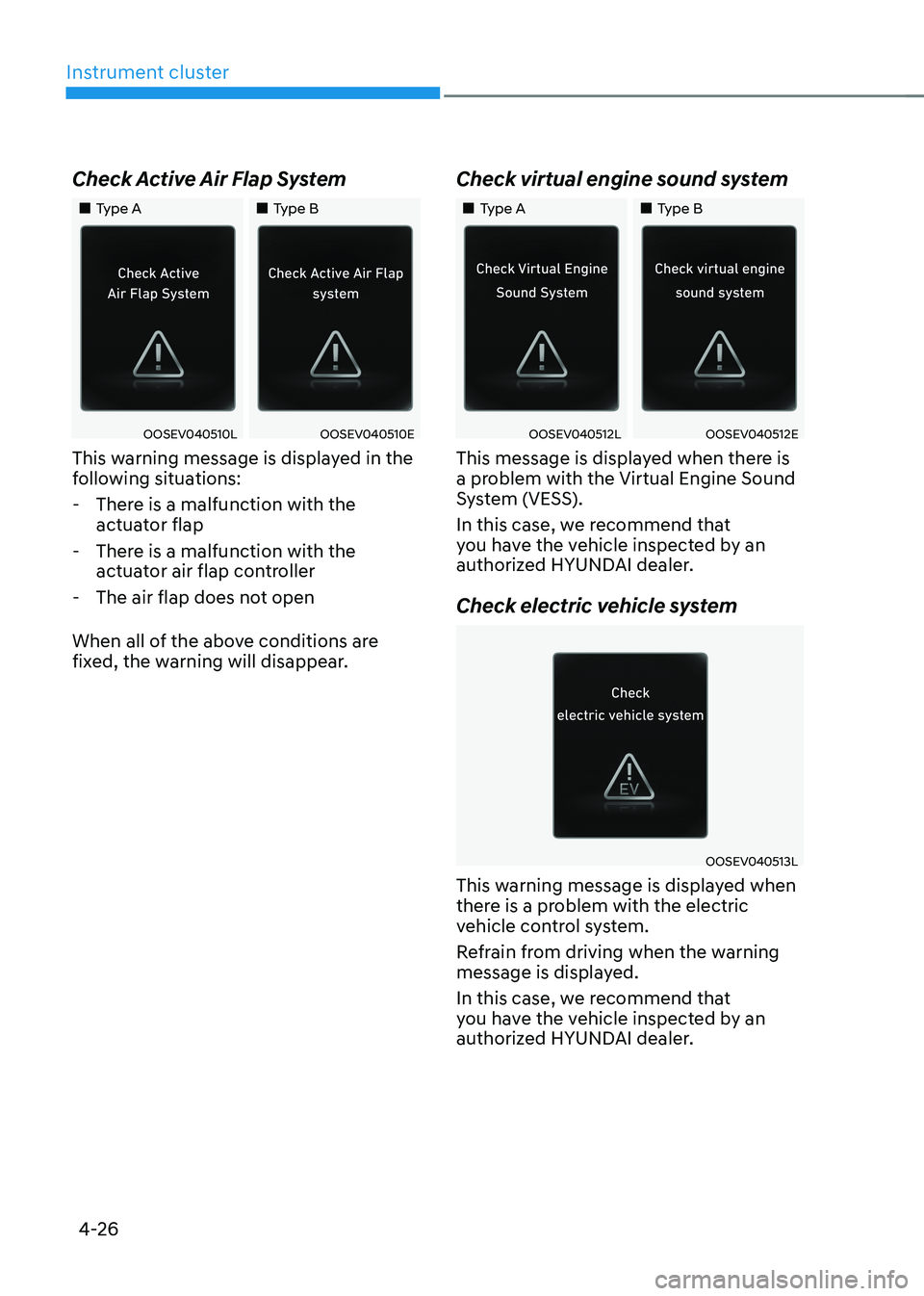
Instrument cluster
4-26
Check Active Air Flap System
„„Type A
„„Type B
OOSEV040510LOOSEV040510E
This warning message is displayed in the
following situations:
- There is a malfunction with the actuator flap
- There is a malfunction with the actuator air flap controller
- The air flap does not open
When all of the above conditions are
fixed, the warning will disappear. Check virtual engine sound system
„„Type A
„„Type B
OOSEV040512LOOSEV040512E
This message is displayed when there is
a problem with the Virtual Engine Sound
System (VESS).
In this case, we recommend that
you have the vehicle inspected by an
authorized HYUNDAI dealer.
Check electric vehicle system
OOSEV040513L
This warning message is displayed when
there is a problem with the electric
vehicle control system.
Refrain from driving when the warning
message is displayed.
In this case, we recommend that
you have the vehicle inspected by an
authorized HYUNDAI dealer.
Page 377 of 548
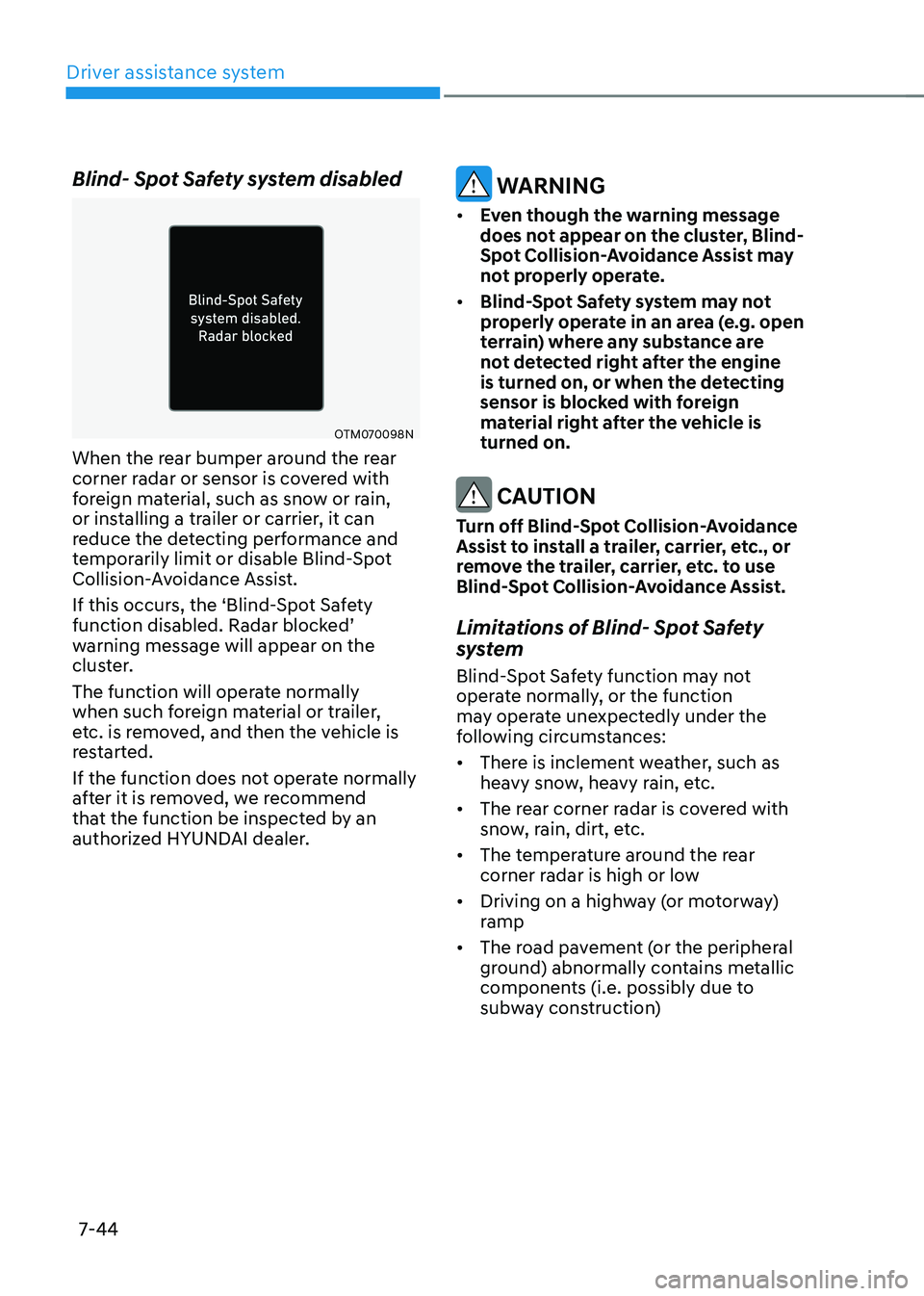
Driver assistance system
7-44
Blind- Spot Safety system disabled
OTM070098N
When the rear bumper around the rear
corner radar or sensor is covered with
foreign material, such as snow or rain,
or installing a trailer or carrier, it can
reduce the detecting performance and
temporarily limit or disable Blind-Spot
Collision-Avoidance Assist.
If this occurs, the ‘Blind-Spot Safety
function disabled. Radar blocked’
warning message will appear on the
cluster.
The function will operate normally
when such foreign material or trailer,
etc. is removed, and then the vehicle is
restarted.
If the function does not operate normally
after it is removed, we recommend
that the function be inspected by an
authorized HYUNDAI dealer.
warning
• even though the warning message
does not appear on the cluster, Blind-
Spot Collision-Avoidance Assist may
not properly operate.
• Blind-spot safety system may not
properly operate in an area (e.g. open
terrain) where any substance are
not detected right after the engine
is turned on, or when the detecting
sensor is blocked with foreign
material right after the vehicle is turned on.
CAUTION
turn off Blind-spot Collision-avoidance
Assist to install a trailer, carrier, etc., or
remove the trailer, carrier, etc. to use
Blind-spot Collision-avoidance assist.
Limitations of Blind- Spot Safety
system
Blind-Spot Safety function may not
operate normally, or the function
may operate unexpectedly under the
following circumstances: • There is inclement weather, such as
heavy snow, heavy rain, etc.
• The rear corner radar is covered with
snow, rain, dirt, etc.
• The temperature around the rear
corner radar is high or low
• Driving on a highway (or motorway)
ramp
• The road pavement (or the peripheral
ground) abnormally contains metallic
components (i.e. possibly due to
subway construction)